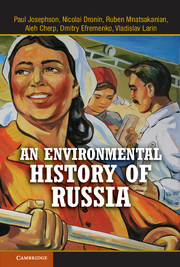Book contents
- Frontmatter
- Contents
- Introduction
- 1 From Imperial to Socialist Nature Preservation
- 2 Stalinism
- 3 The Khrushchev Reforms, Environmental Politics, and the Awakening of Environmentalism, 1953–1964
- 4 Developed Socialism, Environmental Degradation, and the Time of Economic “Stagnation,” 1964–1985
- 5 Gorbachev's Reforms, Glasnost, and Econationalism
- Conclusion After the Breakup of the Soviet Union
- Index
- References
2 - Stalinism
Creating the Socialist Industrial, Urban, and Agricultural Environment
Published online by Cambridge University Press: 05 April 2013
- Frontmatter
- Contents
- Introduction
- 1 From Imperial to Socialist Nature Preservation
- 2 Stalinism
- 3 The Khrushchev Reforms, Environmental Politics, and the Awakening of Environmentalism, 1953–1964
- 4 Developed Socialism, Environmental Degradation, and the Time of Economic “Stagnation,” 1964–1985
- 5 Gorbachev's Reforms, Glasnost, and Econationalism
- Conclusion After the Breakup of the Soviet Union
- Index
- References
Summary
During the New Economic Policy of the mid-1920s, the state focused more on economic recovery than on large-scale mining, metallurgy, forestry, fisheries, and geological engineering projects, although it insisted on controlling the “commanding heights” of industry. By the late 1920s, in a period of relative economic stability, if growing political intrigues involving who would succeed Lenin, the Bolsheviks were prepared to subject nature itself to their plans, no less than industry or labor. Stalin's self-proclaimed Great Break with past social, political, and economic policies involved – among other things – programs for rapid industrialization and collectivization of agriculture that had long-term extensive environmental impacts. Engineers who suggested a circumspect approach to construction projects, dams, forestry enterprises, and so on risked facing charges of subversion or wrecking. Stalinism was therefore not only a polity and economic program, but also a transformationist doctrine that would rebuild nature and the people in it for the “socialist reconstruction” of the nation.
During the Stalin era, party officials, economic planners, and engineers joined in the effort to master the empire's extensive natural resources toward the end of economic self-sufficiency and military strength. At their order, armies of workers began the process of constructing giant dams and reservoirs on major European rivers – the Don, Dniepr, and Volga. Irrigation systems spread across vast arid and semiarid areas of Central Asia, although never to the scale that planners hoped. The workers erected massive chemical combines, metal smelters, and oil refineries in both European and Siberian parts of the country, paying little attention to the pollution they produced. They put up entire cities to house the laborers, whom they exhorted to meet plans and targets irrespective of the environmental costs and the risks to the workers’ own health and safety. A major aspect of the labor enterprise was slave labor camps of the gulag system, which had their own environmental – and, of course, human costs.
- Type
- Chapter
- Information
- An Environmental History of Russia , pp. 71 - 135Publisher: Cambridge University PressPrint publication year: 2013



